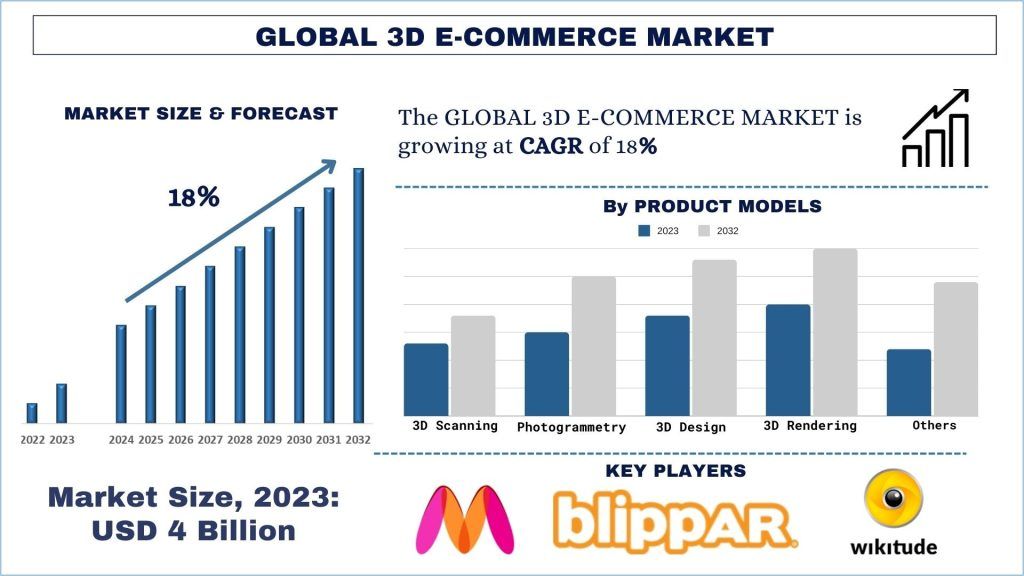
According to a new report by UnivDatos, the 3D E-commerce Market is expected to reach USD 17 Billion in 2032 by growing at a CAGR of ~18%. 3D e-commerce is a subsegment of the broad e-commerce industry that employs 3D imaging and AR/VR (Augmented Reality/ Virtual Reality) to get closer to the customers’ experience. This market is growing because modern customers demand product quality and convenience, particularly the expertise that realistically imitates a purchase process. The 3D E-com offers more convenient purchasing possibilities in a realistic virtual environment where consumers get unique interactive and efficient shopping services. The global market has the potential to expand in the years to come because of the constant advancement of technology and the rise of consumer demands for a better experience while browsing websites. Therefore, the companies that invest in these technologies and are ready to meet the challenges resulting from their implementation are likely to become leaders in this emergent market.
MARKET DRIVERS:
Owing to the further development of 3D modeling software, hardware, and software technologies for augmented reality and virtual reality, the availability and quality of 3D e-commerce solutions have increased significantly. They use these technologies to offer detailed product views and to create ideal customer experiences to minimize customer returns. Modern buyers expect to have a more engaging experience when shopping online today. 3D online shops can rotate the product around, even zoom into some areas of the product, and place virtual objects in real-life situations through AR apps. This advanced visualization assists purchasers in making better decisions when procuring the best products. Consumers can now access 3d content on handheld devices such as smartphones and tablets, hence grasping the opportunity at their disposal. There is an increasing focus observed in e-commerce platforms, which adapt 3D or AR functions to mobile applications, promoting the use of these parameters.
Access sample report (including graphs, charts, and figures): https://univdatos.com/reports/3d-e-commerce-market?popup=report-enquiry
KEY MARKET SEGMENTS:
1. Fashion and Apparel: This segment has gained the use of 3D technology within this segment for dressing to see how products would fit them depending on their body shapes and sizes. It is necessary to locate companies that function in this segment, and such examples can be ASOS and Nike.
2. Home goods and furniture: Various companies like Wayfair, IKEA, and others have come up with augmented reality apps that enable users to see how furniture or even decorative items would look in their homes or other spaces they wish to buy them for before actually buying them.
3. Consumer electronics: 3D online shopping enables customers to interact with the appearance of the products and a variety of electronics through real-like images and information about the product’s usage as well as structural features. These technologies are being integrated into companies’ systems, such as Best Buy, Newegg, and others.
4. Beauty and Personal Care: Some of Sephora’s or Ulta Beauty’s applications of allied reality can be used to help consumers try products on and enhance their shopping experience.
FUTURE TRENDS:
AI helps in enhancing 3D e-commerce as it gives only suggestions and helps enhance the precision of the virtual fitting. With the increase of applications in AR and VR, the integration of such into e-commerce sites will be faster and make the customer experience much more personal. Many social media apps actively integrate features such as 3D and AR, where users can make purchases within their feeds. This trend is likely to increase further, especially considering that it is well-embraced by social media apps such as Instagram and TikTok, among others. As consumers become more environmentally concerned, 3D shopping has the potential to help alleviate the need for sample and return items, hence making more environmentally responsible decisions.
The report suggests that the Rising Adoption of Web-Based 3D Solutions is a significant factor driving the growth of the 3D E-commerce market in the coming years. For instance, in June 2023, Nextech3D.AI, a Generative AI-powered 3D model supplier for Amazon, P&G, Kohl, and other major e-commerce retailers, announced several exciting new deals and renewals for its 3D modeling business, “ARitize3D”. Also, the company surpassed over 37,700 3D models delivered to its customers in various e-commerce industries. Web-based 3D solutions are a key factor that influences the increase in the share of the 3D e-commerce market. These solutions enhance the e-commerce experience for consumers because they can visualize the product in three dimensions since the application is a step up from the often still, two-dimensional images presented online. It also allows customers to gain better impressions of products, resulting in lower return rates and contributing to customer satisfaction and confidence in purchasing. Additionally, web-based 3D solutions are expanding into applications that include augmented reality (AR), providing customers with a real-life look at products within their own space and enhancing the interaction and purchase rate.
Click here to view the Report Description & TOC: https://univdatos.com/reports/3d-e-commerce-market
3D Design Segment Gaining Maximum Traction in the Market
The 3D design segment of the market has expanded considerably due to the growing technology use and customer expectations for innovative e-commerce services. This segment revolves around developing very intricate as well as functional 3D representations of products that the end users can use to get an almost lifelike feel of their experience at virtual shops. These three-dimensional models serve the purpose of giving consumers better and more detailed views of products by eradicating the dimensions and textures that a two-dimensional image or drawing would not be able to depict. While using 3D design in the manufacturing of products is already a great step forward, the addition of AR and VR technologies into the segment has expanded it even more. Consumers can preview products in their natural environment through AR or experience the products in a simulated environment by using VR technology, which can enhance consumer interest and decrease the ambiguity typically seen in online purchasing. In conclusion, the increase in the 3D design segment is due to the developments in the 3D e-commerce market, the demand for engaging and immersive experiences by consumers, and the investment of key market players. It should continue to grow in the future as many firms recognize the importance of using 3D design in their e-business strategies.
Conclusion
The global 3D E-commerce market is rapidly growing, with advancements in the consumer goods industry leading to improved outcomes. The global market is expected to increase as new innovative products are developed in the coming years. Thus, the international 3D E-commerce market represents a significant opportunity for companies to make strategic alliances to launch innovative and user-friendly services. With continued development, more products will likely become available, improving consumer outcomes.
Contact Us:
UnivDatos
Contact Number – +1 978 733 0253
Email – contact@univdatos.com
Website – www.univdatos.com
Linkedin- https://www.linkedin.com/company/univ-datos-market-insight/mycompany/





